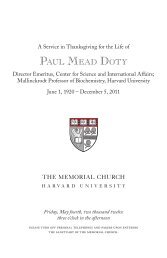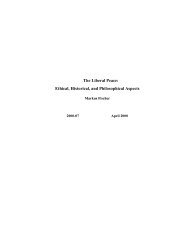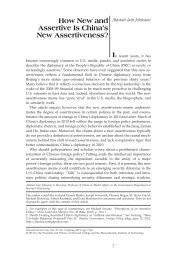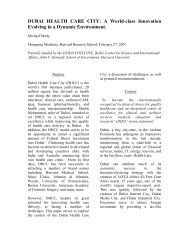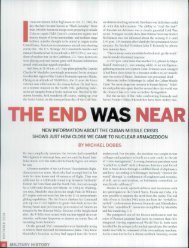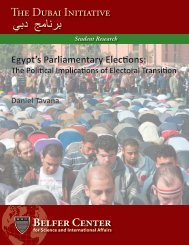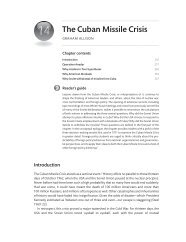Warlordism in Comparative Perspective - MIT Press Journals
Warlordism in Comparative Perspective - MIT Press Journals
Warlordism in Comparative Perspective - MIT Press Journals
You also want an ePaper? Increase the reach of your titles
YUMPU automatically turns print PDFs into web optimized ePapers that Google loves.
<strong>Warlordism</strong> <strong>in</strong> <strong>Comparative</strong> <strong>Perspective</strong> 63<br />
CPC leaders from urban areas conv<strong>in</strong>ced Ch<strong>in</strong>ese peasants to rebel aga<strong>in</strong>st unfair<br />
local land arrangements. The second factor, aga<strong>in</strong> parallel<strong>in</strong>g events <strong>in</strong><br />
Europe, was the emergence of a new transformative idea: <strong>in</strong> this case, nationalism<br />
imported from the West and Japan, whose emphasis on a common identity<br />
of citizens across a vast geographic space aga<strong>in</strong>st both foreign <strong>in</strong>tervention and<br />
parochial disarray helped support the <strong>in</strong>tertw<strong>in</strong>ed goals of anti-imperialism<br />
and anti-warlordism.<br />
economic change and grievance <strong>in</strong> ch<strong>in</strong>a. Ch<strong>in</strong>a’s warlords were as<br />
arbitrary as those of medieval Europe, and certa<strong>in</strong>ly their particularistic rule<br />
and their habit of constant battle impeded long-distance trade. But Ch<strong>in</strong>a’s<br />
merchants did not rise up to challenge warlord rule <strong>in</strong> the early twentieth century<br />
by themselves, even though they supported the anti-warlord labor movements<br />
of the 1920s. In part, this may have been because traditional Confucian<br />
norms did not place merchants at the top of the social hierarchy; <strong>in</strong>stead it was<br />
village culture that received society’s greatest respect. In part, it may also have<br />
reºected the lack of economic opportunity <strong>in</strong> Ch<strong>in</strong>a at the time of warlord rule;<br />
there was no spike <strong>in</strong> productivity as there had been <strong>in</strong> medieval Europe. Control<br />
of the national railroad—a crucial piece of <strong>in</strong>frastructure for the expansion<br />
of long-distance trade—was subject to constant battles between the prov<strong>in</strong>ces<br />
and the center, 90 and prov<strong>in</strong>cial merchant elites often made common cause<br />
with local warlords aga<strong>in</strong>st the state <strong>in</strong> conºicts over taxation and resource distribution.<br />
91 The railway system and the commerce that moved along it were<br />
also a prime target for both banditry and warlord territorial battles. 92 Only the<br />
port towns protected by foreign commercial <strong>in</strong>terests had a chance of spawn<strong>in</strong>g<br />
much trade.<br />
Labor and <strong>in</strong>tellectual <strong>in</strong>terests, <strong>in</strong>itially supported by merchants and later<br />
jo<strong>in</strong>ed by peasants, led the tide aga<strong>in</strong>st warlord rule. The dom<strong>in</strong>ance of several<br />
key warlords was tangled up with the presence of foreign troops on Ch<strong>in</strong>ese<br />
soil to protect the economic <strong>in</strong>terests of foreign ªrms. Their brutality toward<br />
Ch<strong>in</strong>ese laborers, and their unfair practices aga<strong>in</strong>st local merchants, helped<br />
spark <strong>in</strong>itial protests <strong>in</strong> the cities.<br />
The story beg<strong>in</strong>s with the May 4 Movement of 1919. The Ch<strong>in</strong>ese government<br />
<strong>in</strong> Beij<strong>in</strong>g, dom<strong>in</strong>ated by the Beiyang Army warlord faction, was poised<br />
to sign a provision of the Versailles treaty (end<strong>in</strong>g World War I) that would<br />
have made the wartime Japanese occupation of parts of Ch<strong>in</strong>a a permanent<br />
transfer of sovereign territory. Students <strong>in</strong> Beij<strong>in</strong>g protested aga<strong>in</strong>st this deci-<br />
90. Sheridan, Ch<strong>in</strong>a <strong>in</strong> Dis<strong>in</strong>tegration, p. 39.<br />
91. Van de Ven, “Public F<strong>in</strong>ance and the Rise of <strong>Warlordism</strong>,” pp. 860–861.<br />
92. Lary, “Violence, Fear, and Insecurity,” p. 59.



